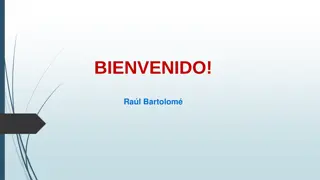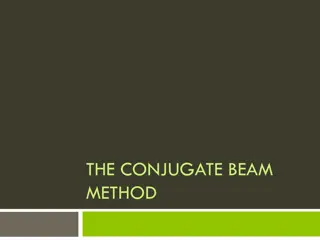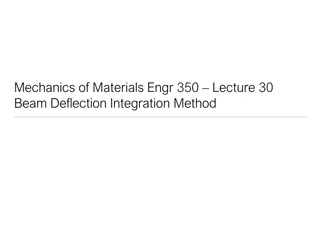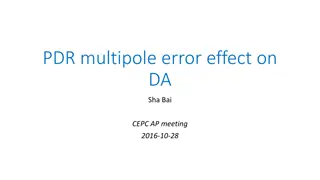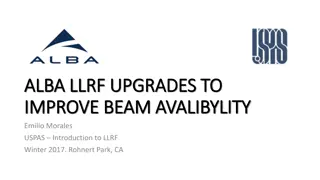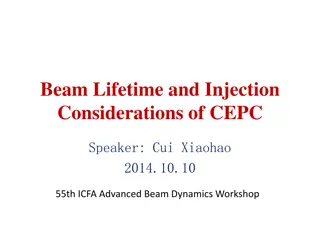Challenges in ATF3 Beam Dynamics Considerations by Andrea Latina
The final focus system in a linear collider, such as ATF3, is challenging due to imperfections like wakefields, magnets misalignment, and beam jitter. The design goals at ATF2 were ambitious but faced difficulties in achieving the desired beam size. Imperfections like dipole/quadrupole misalignment, BPM misalignment, sextupole misalignment, and ground motion/vibrations have detrimental effects but can be mitigated through careful pre-alignment, adding correctors, or using beam-based alignment techniques. The presence of nonlinearities and other issues require thorough diagnostics and corrective measures during operation.
Download Presentation

Please find below an Image/Link to download the presentation.
The content on the website is provided AS IS for your information and personal use only. It may not be sold, licensed, or shared on other websites without obtaining consent from the author.If you encounter any issues during the download, it is possible that the publisher has removed the file from their server.
You are allowed to download the files provided on this website for personal or commercial use, subject to the condition that they are used lawfully. All files are the property of their respective owners.
The content on the website is provided AS IS for your information and personal use only. It may not be sold, licensed, or shared on other websites without obtaining consent from the author.
E N D
Presentation Transcript
ATF3 beam-dynamics considerations Andrea Latina 5th ATF3 meeting 4 Dec 2020
The context The final focus system is among the most challenging sections of a linear collider Very large beta functions and the presence of nonlinear elements make it extremely sensitive to imperfections Wakefields introduce energy spread, bunch head-to-tail distortions, and amplify transverse deflections Magnets misalignment introduce dispersion, beta-beating, orbit deflections, transverse coupling, Beam jitter unavoidably cause betatron oscillations that propagate all the way to the IP, etc. In the ILC and CLIC, the much shorter bunch length much shorter bunch length and the much larger beam energy situation simpler much larger beam energy make the ATF2 tackles its critical task with two major disadvantages w.r.t. its bigger brothers: The bunch length is much longer: 7 mm 7 mm vs 300 The beam energy is significantly lower: 1.3 GeV 1.3 GeV vs 125 GeV 300 m m, about 25 times larger 125 GeV, , about 100 times smaller 25 times larger 100 times smaller
ATF2 goals are (were) challenging The design IP beam size is 37 nm [from Pierre Korysko s thesis] The simulation work made by Pierre, for instance, has shown that, when realistic effects are considered, the design IP beam size size cannot be achieved cannot be achieved not even in simulation (at least, not at full beam intensity) the design IP beam Pierre s work focused on: 1. Assessing the problem, and 2. Finding mitigation techniques to be tested experimentally For ATF3: we should perform a dedicated study of what can be improved by design
Imperfections / issues Detrimental effect Potential cures (by design or hardware improvement) Potential cures (during operation) Dipole / quadrupole misalignment Introduces unwanted dispersion (emittance growth) Deflects the beam Introduces coupling Careful pre-alignment Add a dipole corrector, or Put quads on movers Add skew quads to correct coupling BBA techniques If movers are available, align the quads Bpm misalignment Causes wakefields effects Falses beam-based alignment algorithms Reduce wakefields Careful pre-alignment Put bpms on movers DFS, WFS If movers are available, align the bpms Static Poor bpm resolution Fools beam-based alignment algorithms Better resolution Statistical averaging (but suffers from jitter) Sextupole misalignment Introduces coupling, beta- beating Careful sextupole pre-alignment Put sextupole on movers If movers are available, align the sextupoles Presence of sextupoles (and octupoles) Introduces nonlineartities reduce the momentum acceptance, etc. Revisit the optics to reduce strength Add skew quadrupoles to correct coupling Tuning knobs Beam-based coupling correction techniques Design Lack of diagnostics Forces blind operation Careful design of diagnostic sections Use the diagnostics Long bunches Amplifies wakefield effects Bunch compressor [likely not possible] Dynamic Beam jitter All of the above Reduce jitter at the source Feedback systems Ground motion / vibrations All of the above Stabilization Stabilization
Design consolidation and beam performance assessment The design IP beam size in nominal conditions is 37 nm Imperfections necessarily degrade it Realistic simulations are needed, including realistic imperfections Need to assess how large is the jitter from the damping ring is, in absolute numbers The result of the simulations should drive design choices Define what we should reasonably expect (given the known and existing limitations) E.g. In ATF2/3 intensity-dependence parameter, w, will likely never go to zero We need to (re)define what success means E.g. perhaps achieving goals 1 and 2 at 10% of the nominal intensity could be sufficient to demonstrate the ILC and CLIC FFS feasibility
ATF3 I think that, in view of the ILC, ATF3 should demonstrate: That the operational performance matches the expectations (i.e., realistic simulations) That the design beam size can be achieved routinely and reliably -- possibly through automatic tuning algorithms, like those envisaged for ILC and CLIC I believe that, to achieve reliable operation, we need to: Reduce the incoming beam jitter Stabilize the machine Have more usable diagnostics Calibrated BPMs Beam size / beam emittance monitors Reliable IPBSM Have automated steering procedures (or work towards having them)
From ATF2 to ATF3 Assess the ATF2 jitter at the extraction from the DR We need to perform dedicated beam dynamics studies to identify the most promising performance improvements to the beam performane, e.g. Jitter reduction, how impactful is it? Relaxing the optics, how does that impact the tuning procedure performance? Reducing the wakefields source (hardware change) Identifying what elements could / should be put on movers Define realistic goals to be achieved That is, define what do we call success (i.e., do we really need to squeeze the beam at full beam intensity, to claim that ILC will work?) To do list / Resources needed: Dedicated measurements (e.g. jitter assessment) in the short term In ATF3, improve diagnostics to ease operation Perform performance studies to compare different options: I believe that one PhD student could do the job


